|
|
|
Sort Order |
|
|
|
Items / Page
|
|
|
|
|
|
|
| Srl | Item |
| 1 |
ID:
177941


|
|
|
|
|
| Summary/Abstract |
This article explores the lives and careers of two people from left-leaning, political families in Kolkata. Their formative years and political horizons were shaped by the Left Front government in West Bengal (1977–2011), and they now negotiate the aftermath of the communists’ defeat in 2011 in their day-to-day lives. Buddha was born in Bangladesh, and is now a grassroots leader of the Communist Party of India (Marxist) in suburban Kolkata. His story encapsulates the struggle of building a political career in the aftermath of electoral defeat, mixing the pragmatism of being an important organizer or ‘party man’ with his commitment to cultural politics. Nilima is a young woman from a Leftist family employed by a microfinance institution (MFI). Her upbringing around the party and imbued with communist ideological values now conflicts with a thoroughly neoliberal workplace. Their experiences both in terms of their activism as well as their day-to-day experiences of work in Kolkata’s neighbourhoods offers insights into the contemporary political moment in the city after communism.
|
|
|
|
|
|
|
|
|
|
|
|
|
|
|
|
| 2 |
ID:
158293
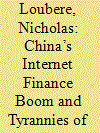

|
|
|
|
|
| Summary/Abstract |
One of the main drivers of China’s e-commerce boom is the dramatic expansion of the country’s Internet finance industry, which has grown and diversified at a staggering rate over the past decade. The emergence of Chinese Internet finance has been discussed in largely positive terms as facilitating commercial activity. It has also been linked to the wider developmental goal of promoting financial inclusion through the provision of financial services to previously excluded populations. Emerging from the global microfinance movement, the concept of financial inclusion depicts increased access to financial services (particularly credit) as an inherently beneficial means of empowering the poor and driving bottom-up economic development. This article challenges this dominant narrative of beneficial digital financial inclusion in China. It draws on the growing body of literature critiquing the global financial inclusion movement, and examines examples of exploitation, fraud, instability, and extraction related to expanded digital financial coverage in contemporary China. It then demonstrates that digital financial inclusion is part and parcel of the Chinese government’s plans to create a social credit system in an attempt to construct a “trustworthy society.” In this way, digital financial inclusion can be seen as a key element in a wider project of expanding surveillance through big data in order to close down spaces for those seeking to contest the hegemonic socioeconomic order. The article argues that these examples illuminate fundamental processes implicit in the expansion of the commercial Internet finance industry. In this way, while the extension of digital financial inclusion in China benefits certain groups, it also necessarily serves to reproduce patterns of inequality and exploitation.
|
|
|
|
|
|
|
|
|
|
|
|
|
|
|
|
| 3 |
ID:
147612
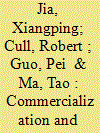

|
|
|
|
|
| Summary/Abstract |
Front-line loan officers of microfinance institutions (MFIs) are important in acquiring information on potential borrowers and selecting them in accordance with the MFI's mission. We use a unique data set on loan officers and their loan portfolios from China's largest NGO microfinance institution to test whether officers' personal characteristics affect the size and quality of their loans. We study a period in which the institution shifted from reliance on government donations and subsidies to commercial sources of funding. Imposing more commercial incentives on loan officers could affect how they balance potentially competing objectives to serve the poor and pursue profitability. We find that loan officers who were formerly farmers or worked in local government were better able to maintain lending to poorer borrowers, without incurring substantially lower repayment rates on their loans. In short, it appears that the career backgrounds of loan officers did play a role in preventing mission drift.
|
|
|
|
|
|
|
|
|
|
|
|
|
|
|
|
| 4 |
ID:
110111
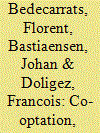

|
|
|
|
|
| Publication |
2012.
|
| Summary/Abstract |
The past decade has been marked by the resurgence of leftist political movements across Latin America. The rise of the 'new left' masks the ambivalent relationships these movements have with broader society, and their struggle to find an alternative to the prevailing development model. Filling the void left by failed public banks, the microfinance sector has grown significantly across the continent in an increasingly commercial form. Analysis of Nicaragua, Ecuador and Bolivia reveals that their new governments share a common distrust of microfinance. Yet, in the absence of viable alternatives for financial service provision, governments and microfinance stakeholders are forced to coexist. The environment in which they do so varies greatly, depending on local political and institutional factors. Some common trends can nevertheless be discerned. Paradoxically, the sector seems to be polarised into two competing approaches which reinforce the most commercially oriented institutions on the one hand, and the most subsidised on the other, gradually eliminating the economically viable microfinance institutions which have tried to strike a balance between social objectives and the market.
|
|
|
|
|
|
|
|
|
|
|
|
|
|
|
|
| 5 |
ID:
121776
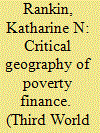

|
|
|
|
|
| Publication |
2013.
|
| Summary/Abstract |
This paper builds a critical geography of poverty finance with recourse to a relational comparison of the microfinance and subprime mortgage markets. It probes paradoxical claims about the nature of poverty, the poor, states and markets that have surfaced in the aftermath of the financial crisis. In doing so it aims to generate new understandings of neoliberal global finance with specific emphasis on 1) the social constitution of risk through racialised and gendered forms of difference; 2) the exercise of dispossession and imperialism by financial means; and 3) articulations of poverty finance with the social relations of debt in specific conjunctures. Each of these terrains of inquiry forms a subsection of the paper, following a preliminary section that poses the animating paradox in more detail. The paper concludes with some reflections on the conditions of possibility for democratising finance.
|
|
|
|
|
|
|
|
|
|
|
|
|
|
|
|
| 6 |
ID:
168481
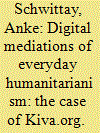

|
|
|
|
|
| Summary/Abstract |
The proliferation of Web 2.0 platforms that aim to facilitate social action, often connected to international development or environmental sustainability, has contributed to the ongoing popularisation of development. In this article, I argue that it has resulted in the digitally-enabled constitution of everyday humanitarians, who are everyday people supportive of poverty alleviation. Kiva.org, a US-based online microlending platform that invites everyday humanitarians to make US$25 loans to Kiva entrepreneurs around the world, is a prime site to study these processes. I show how Kiva cultivates supporters through the mediated production of affective investments, which are financial, social and emotional commitments to distant others. This happens through the design of an affective architecture which in turn generates financial and spatial mediations. While these result in microloans and attendant sentiments of affinity, they also lead to financial clicktivism and connections that obscures the asymmetries and riskscapes resulting from Kiva’s microlending work.
|
|
|
|
|
|
|
|
|
|
|
|
|
|
|
|
| 7 |
ID:
132651


|
|
|
|
|
| Publication |
2014.
|
| Summary/Abstract |
This paper uses Q methodology to reveal stakeholder perceptions on how best to address energy issues in Africa. We sampled a group of stakeholders involved in various energy sub-sectors to uncover perspectives on how to achieve and promote access to modern energy, energy efficiency and renewable energy in Africa, whether the perceptions could be correlated to educational or geographical background and implications such patterns could have on policies and current dialogues.
We found that all stakeholders agree on the need to prioritise sustainability but had different views on how to achieve sustainable energy for all in Africa, depending on the relevance given to each energy driver. Stakeholders could be categorised into four groups: (I) preference of large-scale high-impact projects; (II) supporters of targeted sectoral solutions with preference for small-scale technology and microfinance; (III) supporters of centralised solutions with preference for grid extension, and (IV) supporters of local entrepreneurship with scepticism about centralised solutions. The results show that differences in stakeholders' perceptions can be associated with respondents' educational but not geographical background. This implies that dialogues on energy in Africa should focus on inter-disciplinary understanding while further examining the trans-continent consensus that appears to have been established.
|
|
|
|
|
|
|
|
|
|
|
|
|
|
|
|
| 8 |
ID:
159845
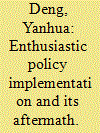

|
|
|
|
|
| Summary/Abstract |
Many China scholars have explored shirking by local officials and “effective implementation,” but fewer have examined polices that are implemented with great enthusiasm. The Microfinance for Women Programme fits in this last category. Especially in Sichuan, targets for lending were set by the province, exceeded, raised by cities and counties, and then exceeded again. The immediate reason that lending took off in 2012 was the relaxation of collateral requirements that shifted the risk of defaults away from local authorities. But the surge in lending also had deeper roots in the policy's vagueness, institutional incentives, bureaucratic pressure, and local fiscal and organizational interests. Although enthusiastic implementation occurred (and generated much-needed revenues for local governments), the history of the programme also shows that it can be halted, as was the case when instability loomed and the authorities reversed bureaucratic pressure by calling for local cost-sharing and introducing uncertainty over whether interest subsidies would continue.
|
|
|
|
|
|
|
|
|
|
|
|
|
|
|
|
| 9 |
ID:
142511
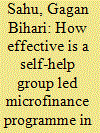

|
|
|
|
|
| Summary/Abstract |
Drawing upon recent data, this paper explores the relationship between women’s involvement in Self-Help Group (SHG) based microfinance programmes and their empowerment. The composite empowerment indicator shows that only 13.2% of women associated with microfinance are empowered. The paper finds that though the length of membership in SHGs increases the intensity of women’s economic and political empowerment, it does not show a significant relationship with their social empowerment. It is also observed that ‘economic empowerment’ does not necessarily lead to the attainment of social and/or political empowerment. The paper argues that although SHG-led microfinance programmes have the potential to empower women in some aspects, their capacity in ushering social transformation is limited.
|
|
|
|
|
|
|
|
|
|
|
|
|
|
|
|
| 10 |
ID:
130054
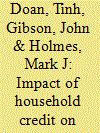

|
|
|
|
|
| Publication |
2014.
|
| Summary/Abstract |
There is an ongoing debate about whether microfinance has a positive impact on education and health for borrowing households in developing countries. To understand this debate, we use a survey designed to meet the conditions for propensity score matching (PSM) and examine the impact of household credit on education and healthcare spending by the poor in peri-urban areas of Ho Chi Minh City, Vietnam. In addition to matching statistically identical non-borrowers to borrowers, our estimates also control for household pre-treatment income and assets, which may be associated with unobservable factors affecting both credit participation and the outcomes of interest. The PSM estimates show a significant and positive impact of borrowing on education and healthcare spending. However, further investigation of the effects of the treatment reveals that only formal credit has a significant and positive impact on education and healthcare spending, while informal credit has an insignificant impact on spending. This paper contributes to the limited literature on peri-urban areas using evidence from one of the largest and most dynamic cities in Southeast Asia.
|
|
|
|
|
|
|
|
|
|
|
|
|
|
|
|
| 11 |
ID:
101156
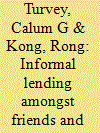

|
|
|
|
|
| Publication |
2010.
|
| Summary/Abstract |
This paper explores the relationship between informal and formal lending in China with consideration of how the strength of informal lending might affect microcredit. Lending relationships involving trust are investigated using original survey data from over 1500 farm households. Econometric results confirm a relationship between trust and informal lending, and mistrust and formal lending. With over 67% of farm households borrowing from friends and relatives the economic significance between this form of informal lending and borrowing from Rural Credit Cooperatives and Micro Finance Institutions cannot be overlooked.
|
|
|
|
|
|
|
|
|
|
|
|
|
|
|
|
| 12 |
ID:
139481
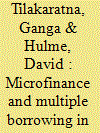

|
|
|
|
|
| Summary/Abstract |
In recent years, there has been an increase in multiple borrowing in the microfinance sector in Sri Lanka, while many microfinance institutions (MFIs) have experienced high levels of borrower turnover, deteriorating portfolio quality and weak financial performance. This has raised concerns about the microfinance sector. However, the debt levels for the majority of borrowers remain at moderate levels, while a number of mitigating factors such as mobilization of borrower savings by MFIs, wide use of pawning among clients and a reduction in donor funds to the sector suggest that a microcredit bubble in Sri Lanka is unlikely in the near future.
|
|
|
|
|
|
|
|
|
|
|
|
|
|
|
|
| 13 |
ID:
101499
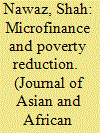

|
|
|
|
|
| Publication |
2010.
|
| Summary/Abstract |
To evaluate the competing claims on the impact of microfinance programs on multidimensional poverty, a village study in Bangladesh was conducted where three microfinance programs had been operating for more than five years. The study found that microfinance has resulted in a moderate reduction in the poverty of borrowers, as measured by a variety of socio-economic indicators, but has not reached many of the poorest in the village. To make microfinance a more effective means of poverty reduction other services such as skills training, technological support, education and health related strategies should be included with microfinance.
|
|
|
|
|
|
|
|
|
|
|
|
|
|
|
|
| 14 |
ID:
133721
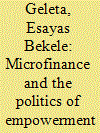

|
|
|
|
|
| Publication |
2014.
|
| Summary/Abstract |
This article challenges the widely accepted assumption that the provision of microfinance to poor women through organizing them in groups empowers them. The current popular thinking in development studies considers microfinance as the best remedy not only for poverty, but also for social disintegration and women's subordination. This article argues that such analysis ignores the cultural roots of inequality, subordination and destitution. Drawing on Bourdieu's sociological frameworks, the article constructs a critical cultural model and elucidates the complexity of gender relations in microfinance process. The article explores gendered cultural norms and expectations that control and influence microfinance practices and contributes towards a more adequate and critical theoretical understanding of its empowerment potential.
|
|
|
|
|
|
|
|
|
|
|
|
|
|
|
|
| 15 |
ID:
180094


|
|
|
|
|
| Summary/Abstract |
Liquidity constraints are a key barrier to acquisition and sustained use of clean household energy in resource-poor settings. This study evaluates a pilot microfinance initiative in Kenya to help low-income rural households access liquefied petroleum gas (LPG) for cooking. Program beneficiaries received a six-month loan that covered all equipment costs and was to be repaid in monthly installments. We present results from surveys of beneficiaries (n = 69) after they began using LPG, as well as 332 non-beneficiaries from the same community (to understand how beneficiaries and non-beneficiaries differ in cooking patterns and socioeconomic outcomes). 94% of beneficiaries had repaid their loan in full and on time at the time of data collection. Meanwhile, beneficiaries were more likely than non-beneficiaries to use LPG as their primary cooking fuel (76.8% of beneficiaries versus 38.8% of non-beneficiaries). While 81.1% of beneficiaries who used LPG as their primary cooking fuel reported multiple fuel use, we find beneficiaries increased LPG use by 5.9 h per week with a corresponding decrease of 4.8 h in weekly use of biomass fuel. Our findings suggest that promoting LPG usage through microloans for equipment is likely to be both commercially viable and beneficial to health through decreased use of polluting biomass fuel.
|
|
|
|
|
|
|
|
|
|
|
|
|
|
|
|
| 16 |
ID:
193048
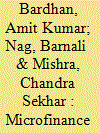

|
|
|
|
|
| Summary/Abstract |
This study evaluates the financial and social efficiency of Indian Microfinance Institutions (MFIs) from 2005 to 2018 and also tries to find out the determinants of financial and social efficiency. In the first step, bias-corrected bootstrap Data Envelopment Analysis (DEA) efficiency scores for financial and social efficiency were calculated using two input and two output variables. In the second step of analysis above efficiency scores have been used as dependent variables and Seemingly Unrelated Regression (SUR) model is employed to ascertain the determinants of financial and social efficiency of Indian MFIs. The study finds that the aggregate financial efficiency of Indian MFIs is higher than the social efficiency. Over the study period, efficiency of Indian MFIs shows an increasing trend. Results of SUR suggest that as compared to Non-Banking Finance Company (NBFC) MFIs, Non-NBFC MFIs’ financial and social efficiency is better. Influence of age, scale of loan portfolio, asset quality and financial leverage on efficiency of MFIs are insignificant. This study also finds that asset size of the firm is positively associated with efficiency. Evidence from this study suggests that reform measures taken post microfinance crises has negatively affected the financial efficiency. However, social efficiency has improved during post reform period.
|
|
|
|
|
|
|
|
|
|
|
|
|
|
|
|
| 17 |
ID:
110110
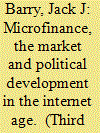

|
|
|
|
|
| Publication |
2012.
|
| Summary/Abstract |
This article steps outside traditional economic analysis of microfinance, and instead investigates the political ramifications of microfinance in developing countries. In particular, I argue that microfinance affects social capital, political empowerment and democratisation. I examine three emerging trends in microfinance: new technology; the rise of for-profit microfinance institutions; and the increase in individual, rather than group microfinance lending. In exploring these trends, I analyse seven prominent institutions: non-profits Kiva, Global Giving, Calvert Organization and MicroCredit Enterprises; and for-profits MicroPlace, MicroVest, and Oikocredit. My findings indicate that different types of microfinance institutions have unique characteristics that influence political development in a variety of ways, including but not limited to: democratisation, social capital, and economic and political empowerment. The article attempts to fill a gap in the literature and open up a conversation as to how differing approaches to microfinance lending influence political development.
|
|
|
|
|
|
|
|
|
|
|
|
|
|
|
|
| 18 |
ID:
068346
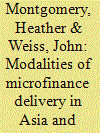

|
|
|
| 19 |
ID:
127056
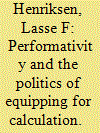

|
|
|
|
|
| Publication |
2013.
|
| Summary/Abstract |
This article argues that the concept of performativity deepens our understanding of contemporary, expertise-driven processes of global economic governance. Tracing the World Bank's role in constructing a global market for microfinance, the paper suggests that the World Bank was instrumental in translating selected parts of economic models into practice, thereby changing microfinance practices globally. Socio-technical networks centered on the World Bank were created to equip actors to become part of a global market, which incorporated not only donors but also commercial investors. The paper makes a critical intervention in the performativity literature by arguing for the need to take positional power and dominance in the socio-technical networks of International Organizations more seriously. This move improves our ability to specify how economic ideas and models are translated into practice in transnational arenas.
|
|
|
|
|
|
|
|
|
|
|
|
|
|
|
|
| 20 |
ID:
183681
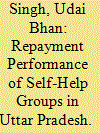

|
|
|
|
|
| Summary/Abstract |
This paper aims to study the determinants of repayment performance of self-help groups in India’s Uttar Pradesh state, which has one of the highest numbers of defaulting self-help groups. The study is based on primary data collected in 2017 through a field survey covering 300 members across 100 self-help groups from the rural areas of Sultanpur and Faizabad districts. The survey reveals an overall repayment rate of about 55% with better pay-back performance seen among members of old self-help groups. The results, computed with the help of the Tobit model, show that factors such as group maturity (age of the group), ratio of family workers to household size and household income are negatively associated with the incidence of delinquency while peer group pressure and social ties associate positively with delays and overdues.
|
|
|
|
|
|
|
|
|
|
|
|
|
|
|
|
|
|
|
|
|